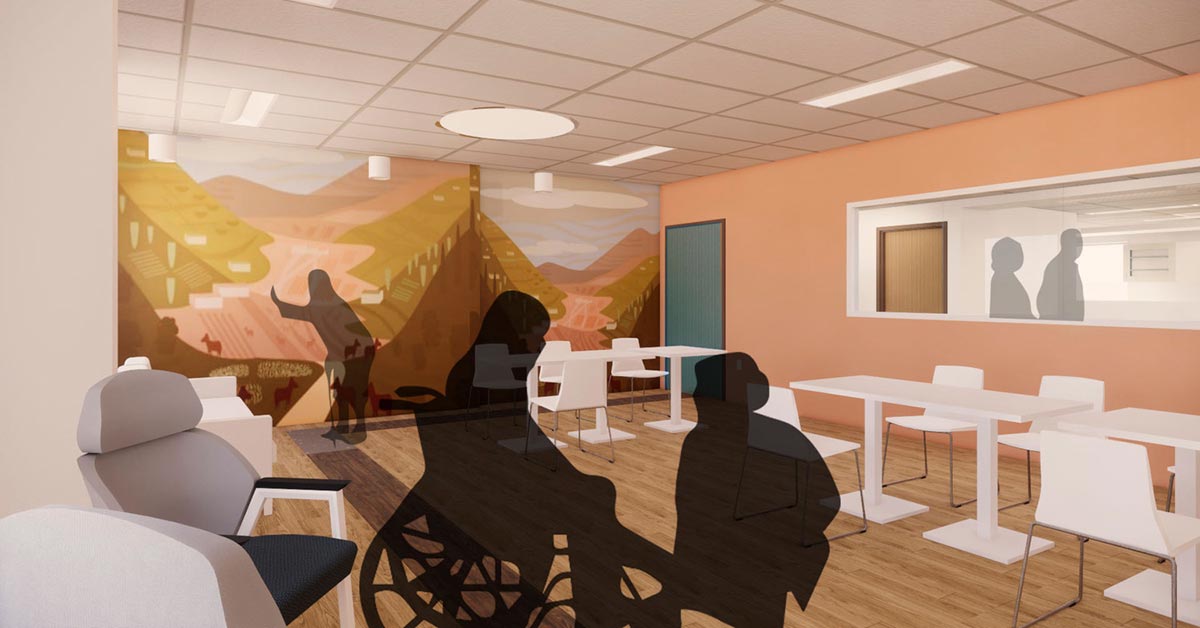
If you’re a pirate, you have a set of rules you must follow called the “Code.” Though, as Captain Hector Barbossa of Pirates of the Caribbean fame said, “The Code is more what you’d call ‘guidelines’ than actual rules.”
When it comes to designing facilities for the care of persons with dementia in the U.S., there are no codes, standards, or even robust guidelines to follow. This is a problem that AJ Thomas and his peers at Corgan are hoping to change.
In 2019, when a group at Corgan was selected as research fellows with Hospice of the Valley, they focused on dementia care and best practices in making an environment dementia friendly.

“Early on, we realized there are no guidelines or standards for [dementia-friendly] design,” said Thomas. “And our behavioral health guidelines that govern design are woefully inadequate.”
Thomas explained that designers of behavioral health facilities might use the information provided by Facilities Guidelines Institute or guidelines provided by the New York Office of Mental Health. However, only some states have their own guidelines. And, as much as designers and regulatory agencies are often at odds, Thomas wishes there were more guidelines and standards on the regulatory side.
“That would be a welcome change,” he said.
Thomas said that when they dug deeper, they found standards or criteria for cities. For example, Tempe, Arizona, is designated as a Dementia Friendly Community, meaning those with dementia continue to have access to the community’s services and support.
Additionally, one place where there are standards that are working is the Veterans Administration (VA), “I want to give kudos to the VA. The VA doesn’t get enough credit for doing things right, at least on the behavioral health side. They’re really good at thinking out of the box. Of course, being a federal agency, you might ask, ‘How cutting edge can they be?’ But if you look at the standards that they have developed for behavioral health, it’s something the rest of the industry needs to take notice of. They’re doing some very innovative stuff.”
However, the lack of one uniform national standard seemed like a void that needed to be filled. “So that became our project for our research effort—creating standards for dementia-friendly places.”
Corgan set out to create guidelines for inpatient and outpatient dementia-friendly healthcare design, hoping that they would become standards at some point, much like ADA guidelines became standards as more research and data became available.
The team started searching for literature on creating dementia-friendly spaces and didn’t find much that was published. Thomas said that much of their work began on foundational research out of Ireland. The country was a leader in dementia-friendly standards as far back as 2014 when the Department of Health published a national dementia strategy.
The year-long program resulted in 12 specific guidelines, which Thomas and others at Corgan have presented at multiple conferences to standing room-only audiences.

Challenges in Creating Guidelines
The team at Corgan encountered several challenges along the way in developing their guidelines. The first was the need to make them specific enough to be helpful. Thomas used “anti-ligature” policies as an example of standards that, when they exist, are too general and too vague. The same design may pass or fail depending on who is doing the survey. If you have an inspector that is very strict, they might pull out a string flagging any potential ligature points. Others might not be so thorough, instead of leaving it subjective or open to interpretation. Thomas believes standards like those that apply to medical centers would be helpful.
Many of the other challenges were design-based. Often, children or family caregivers are the primary deciders in where a person with dementia lives.
“They are, of course, looking for the best possible option, and the more luxurious a facility looks, the more they assume their loved one will enjoy living there,” said Thomas.
However, what appears to be a luxury for the seniors moving in can actually be an obstacle. Thomas said that just because a design wins awards and looks stunning on a magazine cover doesn’t mean it works for the user.
Part of the team’s research included simulating a day in the life of a person under care in order to better understand the challenges faced by senior citizens in general and the needs of patients with dementia. They wore clouded glasses to impair vision, gloves that restrict finger movements to mimic arthritis, and headphones to muffle sound. Then they were given simple daily tasks to perform, such as dressing with limited movement and conversing with limited hearing.
“You begin to realize, oh, my gosh, I didn’t even think about all of this. Walking in the shoes of somebody you’re designing for is the ultimate test. Now instead of thinking, ‘Let me create a beautiful, pretty picture,’ you better understand what the user wants,” said Thomas. “[People impacted by dementia] want more simplicity, not an environment that’s not too overstimulating on the senses.”
Thomas admits that coming up with clear guidelines for stimulation is challenging. Because people with dementia have deteriorating neurons in the brain, overstimulation can lead to a feeling of overwhelm while sensory deprivation can lead to apathy. When you achieve the correct balance, it fosters engagement. The challenge is designing a senior living or behavioral health space that works for everyone—people with dementia and people with other conditions, as well.

Of course, when discussing behavioral health facilities and their need to work for everyone, that includes the staff. So how do you ensure the staff can do their job and provide a comfortable living environment?
Thomas said behavioral healthcare design runs the spectrum from institutional to homelike environments.
“When you overlay the safety criteria—safety to the staff and safety to the patients—your design tends to move towards the institutional look; it looks like a prison. When your design looks more like a home, you’re probably improving some patient outcomes, but you could also risk compromising safety. Designs need to be flexible enough to provide both safety and comfort—an aspect that’s very peculiar to behavioral health,” said Thomas.
For example, Corgan’s guidelines for public spaces recommends alcoves so patients can get out of the hustle and bustle, to stop and rest safely. It also recommends providing comfortable social spaces so patients can connect with others and addresses logistical needs such as easily accessible service counters.
The guidelines for inpatient spaces include a nursing station that’s visible upon entry, a lounge area for family and patients to socialize, seating where patients can rest as they move about the unit, and room identification and wayfinding via color contrast.
“However,” he added, “one aspect common not just to behavioral health, but all healthcare, is staff burnout. Giving the staff spaces for respite, where they can just be, is super important.”
Important, but not without its own challenge. A CFO might question spaces that don’t generate income. “But when you overlay the staff’s wellbeing and the productivity you gain by giving them a space—The ability to take a five-minute break to recharge? It’s priceless.”
Corgan’s guidelines for public spaces also include quiet areas for patients to get away from it all, both indoors and outside. Everyone, patients and staff alike, needs calm, peaceful spots to reset and recharge now and then.

Design Isn’t the Only Challenge for Those Caring for Patients with Dementia
While the Corgan team was focused on the built environment, they did make room to include another guideline they felt was just as important: Staff Awareness.
Thomas says the number one challenge in behavioral health is the associated stigma. He believes that will only go away through education, which is a long process. You cannot just flip a switch; suddenly, everyone understands it’s something you can work through. Getting rid of that stigma once and for all is Thomas’s number one wish.
As for dementia, Thomas thinks it’s less a stigma and more a misperception. He gave the example a caregiver passed on of a patient with dementia who suddenly started removing their clothes. An onlooker might think the issue is mental health-related.
“What’s actually happening is this person is uncomfortable with the temperature setting. What is hot or cold for the general population is not the same when you age. They have a different comfort level, and that person is simply reacting to their environment. If the caregiver understands what’s happening, they can simply lower the temperature,” said Thomas.
To address this need for understanding, the guideline includes dementia-specific staff training and better comprehension of the cost-benefit analysis behind the other guidelines—such as reduced patient injuries, reduced violence and aggression, and improved patient/resident outcomes.
What Facilities Need to Understand About Design
Choose your architect carefully.
Thomas said an unfortunate recent behavioral health trend is engaging a general architect. He explained that while the floor plan may seem simple, a seasoned healthcare firm understands all the core issues. While a general architect might design a beautiful facility, it won’t take long before you realize its beauty is not functional.
For example, consider the design of a behavioral healthcare facility for both children and adults. A firm without the necessary experience may not know that these two demographics have very different needs, and that lack of knowledge can have a detrimental effect on both patients and staff. A general architect may have a good sense of color theory, but not as it applies to those with mental health issues—e.g., calming vs. stimulating. Right now, this knowledge comes from experience. Thanks to the work Corgan is doing, however, one day soon we may have not only guidelines, but standards and—dare we say—codes for dementia-friendly design, just like the ADA Standards for Accessible Design.
